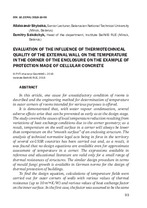| dc.contributor.author | Shybeka, A. S. | en |
| dc.contributor.author | Sakolchyk, D. A. | en |
| dc.coverage.spatial | Минск | ru |
| dc.date.accessioned | 2019-11-19T08:37:57Z | |
| dc.date.available | 2019-11-19T08:37:57Z | |
| dc.date.issued | 2018 | |
| dc.identifier.citation | Shybeka, A. S. Evaluation of the influence of thermotechnical quality of the external wall on the temperature in the corner of the enclosure on the example of protection made of cellular concrete = Оценка влияния теплотехнических качеств наружной стены на температуру в углу ограждения на примере ограждения из ячеистого бетона / A. S. Shybeka, D. A. Sakolchyk // Проблемы современного бетона и железобетона : сборник научных трудов / Министерство архитектуры и строительства Республики Беларусь, РУП "Институт БелНИИС". – Минск : Колорград, 2018. – Вып. 10. – С. 93-102. | en |
| dc.identifier.uri | https://rep.bntu.by/handle/data/59980 | |
| dc.description.abstract | In this article, one cause for unsatisfactory condition of rooms is described and the engineering method for determination of temperature in outer corners of rooms intended for various purposes is offered. It is demonstrated that, with water vapour condensation, several adverse effects arise that can be prevented as early as at the design stage. The study covered the causes of local temperature reduction resulting from variations of heat exchange conditions due to the corner geometry; as a result, temperature on the wall surface in a corner will always be lower than temperature on the “smooth surface” of an enclosing structure. The analysis of technical normative legal acts being in force in the territory of several ex-USSR countries has been carried out and, as a result, it was found that no design equations are available even for approximate assessment of temperature in a corner. The expressions available in reference and educational literature are valid only for a small range of thermal resistances of structures. The similar design procedure in terms of mould fungi growth is available in German norms for the design of thermal protection of buildings. To find the design equation, calculations of temperature fields were carried out for outer corners of walls with various values of thermal resistance (up to 10 m²•K/W) and various values of heat exchange factor on the inner surface. In the first case, the factor was assumed to be the same as the factor on the enclosure “smooth surface”; in the second and third case, its reduction was taken into consideration in accordance with data available from Belarusian scientists and from foreign norms. The result of this research is the derivation of the approximative function, f(R), depending on the thermal resistance of a structure. For convenience of use, the values of this function were tabulated. This design method may be recommended for application by design organizations, with the possible subsequent implementation in construction norms. | en |
| dc.language.iso | en | en |
| dc.publisher | Колорград | ru |
| dc.title | Evaluation of the influence of thermotechnical quality of the external wall on the temperature in the corner of the enclosure on the example of protection made of cellular concrete | en |
| dc.title.alternative | Оценка влияния теплотехнических качеств наружной стены на температуру в углу ограждения на примере ограждения из ячеистого бетона | ru |
| dc.type | Article | ru |
| local.description.annotation | В статье излагается одна из причин неудовлетворительного состояния помещений и предлагается инженерный способ определения температуры в наружном углу помещений различного назначения. Показано, что при конденсации водяного пара возникает ряд негативных последствий, которые можно предотвратить еще на стадии проектирования. Рассмотрены причины локального понижения температуры, вызванные изменениями условий теплообмена вследствие геометрии угла, ввиду чего температура на поверхности стены в углу будет всегда меньше температуры по «глади» ограждающей конструкции. Проведя анализ технических нормативных правовых актов, действующих на территории некоторых стран бывшего СССР, было установлено отсутствие расчетных зависимостей для хотя бы приближенной оценки температуры в углу. Имеющиеся в справочной и учебной литературе выражения справедливы только для малого диапазона термических сопротивлений конструкции. В немецких нормах на проектирование тепловой защиты зданий встречается аналогичный расчет на образование плесневых грибов. Для выявления расчетной зависимости были проведены расчеты температурных полей наружных углов стен с различным термическим сопротивлением (до 10 м²•К/Вт) и различными значениями коэффициента теплообмена у внутренней поверхности. В первом случае коэффициент принимался таким же, как и на «глади» ограждения, во втором и третьем – с учетом его снижения по данным отечественных ученых и зарубежных норм. Результатом исследования явилось получение аппроксимативной функции f(R), зависящей от термического сопротивления конструкции. Для удобства пользования значения данной функции были затабулированы. Данный метод расчета может быть рекомендован для использования проектными организациями с возможным последующим включением в строительные нормы. | ru |

